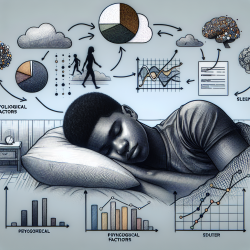Introduction
Sleep disturbances in adolescents are a prevalent concern, affecting approximately 25% of youth. These disturbances are linked to various negative outcomes, including psychological and cognitive impairments. A recent study titled Data-driven, generalizable prediction of adolescent sleep disturbances in the multisite Adolescent Brain Cognitive Development Study provides valuable insights into the multifaceted nature of adolescent sleep issues.
Key Findings
The study utilized Canonical Correlation Analysis (CCA) on data from the Adolescent Brain Cognitive Development (ABCD) Study to identify associations between sleep disturbances and a wide array of psychological, cognitive, and demographic variables. Two significant associations emerged:
- Psychopathology and Sleep Disturbances: Difficulty initiating and maintaining sleep, as well as excessive daytime somnolence, were strongly linked to various domains of psychopathology. This association underscores the importance of considering mental health when addressing sleep issues in adolescents.
- Sleep Breathing Disorders: These were associated with higher Body Mass Index (BMI) and African American/black race. This highlights the need for targeted interventions to address sleep health disparities.
Implications for Practitioners
For practitioners working with adolescents, these findings offer several actionable insights:
- Integrate Mental Health Assessments: Given the strong link between psychopathology and sleep disturbances, practitioners should incorporate mental health evaluations into sleep assessments.
- Consider Socio-Demographic Factors: Awareness of the socio-demographic factors, such as BMI and race, can help in tailoring interventions to individual needs.
- Promote Family and Community Engagement: Addressing family conflict and neighborhood safety may improve sleep outcomes, suggesting a holistic approach to intervention.
Encouraging Further Research
The study's findings open avenues for further research into the complex interactions between various predictors and sleep disturbances. Future studies could explore the longitudinal impact of these associations and the effectiveness of targeted interventions.
Conclusion
Understanding the intricate web of factors affecting adolescent sleep can lead to more effective interventions and improved outcomes. Practitioners are encouraged to apply these data-driven insights in their practice and contribute to ongoing research efforts.
To read the original research paper, please follow this link: Data-driven, generalizable prediction of adolescent sleep disturbances in the multisite Adolescent Brain Cognitive Development Study.










